Looking to password protect your WordPress site with an extra layer of security? If so, you’ve landed at the right place.
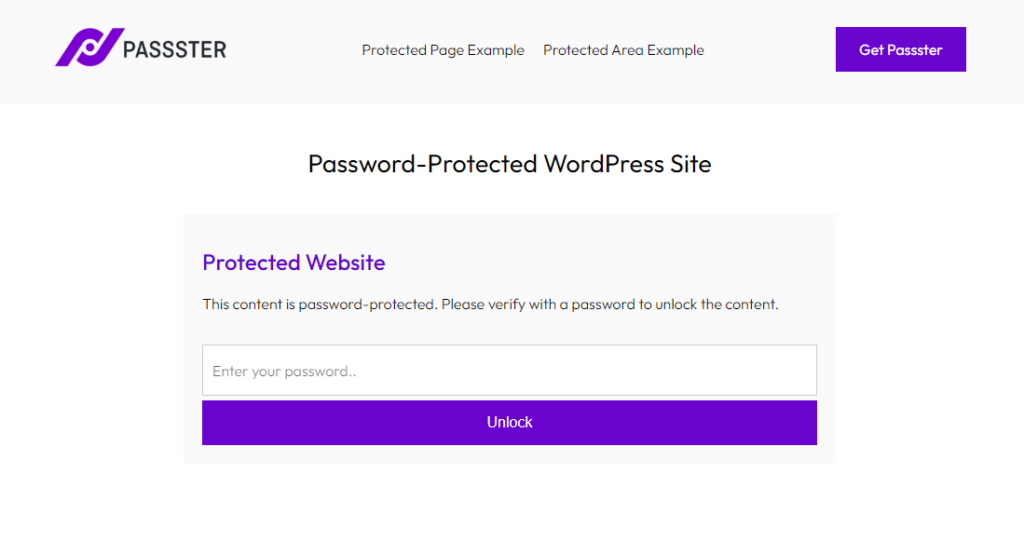
Adding a password to your WordPress site is an effective method to control who can access it, providing extra security for your important content.
So in this article, we’ll show you how to do it. Here’s what we’ll walk you through:
- The difference between a private and password protected WordPress site.
- The best plugin to password protect your WordPress site.
- How to password protect your entire WordPress site.
Passster
Protect your entire website, entire pages, or just parts of your content with one or more passwords.
Let’s start by looking at the difference between a private and a password-protected WordPress site.
What’s the difference between private and password-protected WordPress?
By default, all the pages and posts you publish on your WordPress site are accessible to anyone once your website is online. But what if you want to limit access to certain pages, posts, or your entire website to specific users or groups of users?
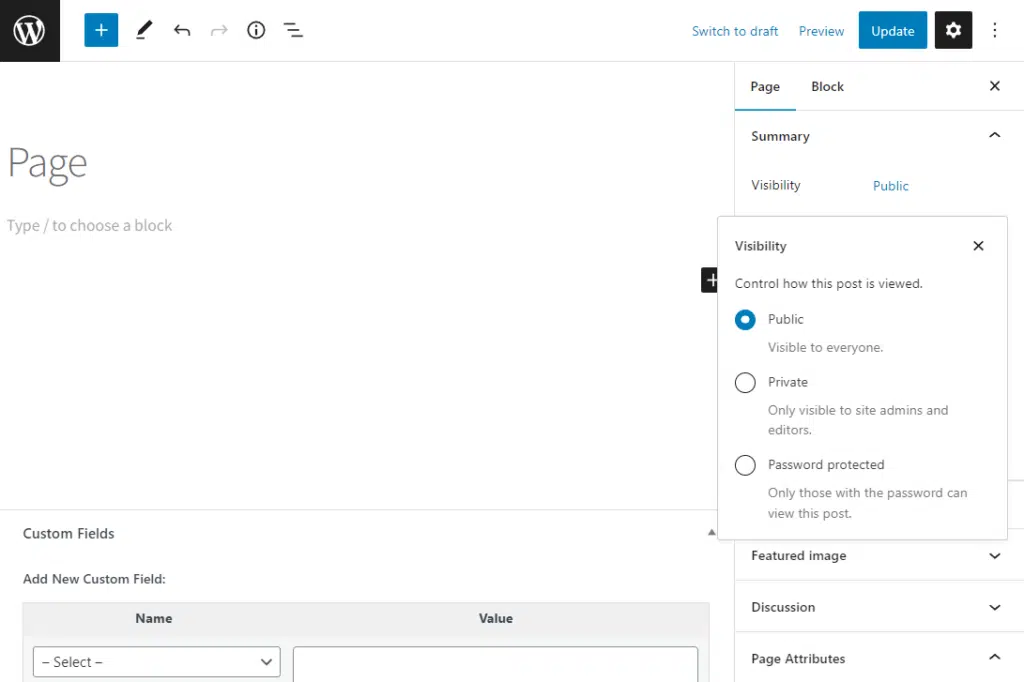
For this, there are two ways you can restrict access to your WordPress website:
- Making it private.
- Password-protecting it.
When you make your WordPress website private, it will be hidden from the public. Even if site visitors have your site’s URL, they won’t be able to access it.
Only the users you’ve granted permission will be allowed to access it. This is usually logged-in users, like admins or editors.
On the other hand, a password protected WordPress site is accessible to anyone, provided they have the correct password. Users will be met with a password protection form whenever they try to access this website. Requiring them to enter the right password before they can see what’s behind the form.
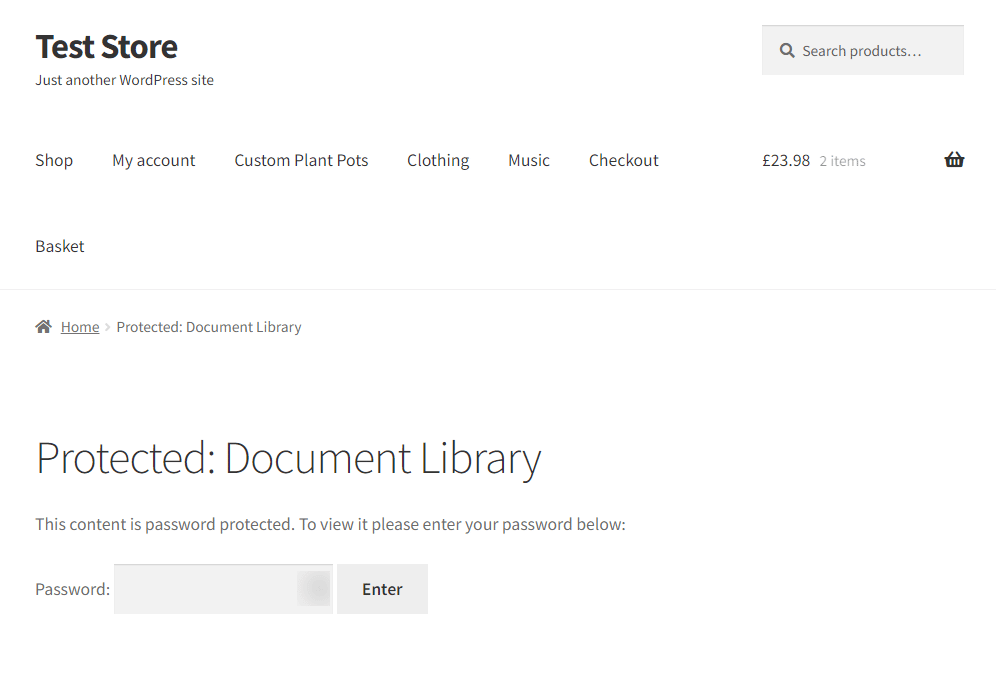
Password protection and making your website private can benefit you as the site owner for various use cases. These two WordPress security options serve similar purposes and have similar use cases. Let’s have a closer look at them, one after the other.
Why you might want to make your WordPress site private
There are many different scenarios in which you should make your WordPress website private.
- To run a private WordPress blog – You may have personal information you want to share with your friends or family, employees, partners, or other stakeholders. By making your blog private, you can control who has access to your content and ensure that confidential information is kept secure.
- Use your website as a testing area – If your organization creates solutions for WordPress, for example, themes or plugins, you’ll need a WordPress website to test them. Making this site private ensures that the public doesn’t access your solutions before you officially release them.
- To run members-only or subscription websites – Making your site private allows you to run a membership or subscription website and give subscribers access to exclusive content. Content like special posts, videos, or any other content. With a private website, you can limit access to exclusive content and encourage non-members to sign up.
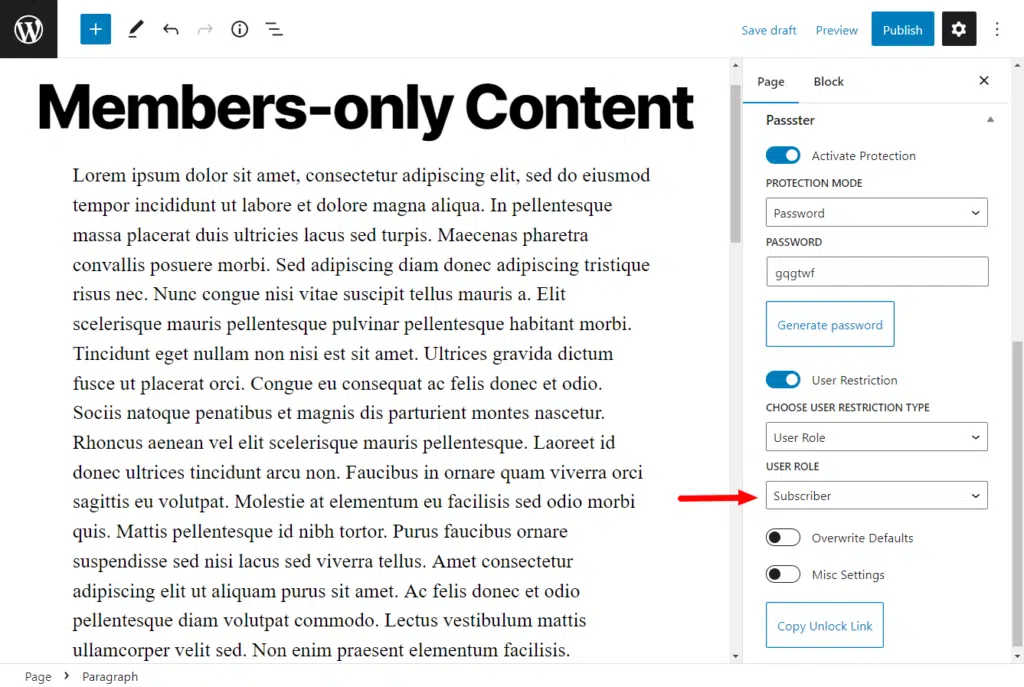
Making your WordPress site private gives you full control over who accesses it. In doing so, you can competently secure your website and its content. Apart from security, this also helps to improve user experience by allowing users only to access what’s relevant to them.
Why you might want to password protect your WordPress site
As a site owner, you may want to password protect your WordPress site in the following scenarios:
- To protect sensitive information – if your website contains sensitive information such as customer addresses, health records, social security numbers, etc., you wouldn’t want everyone to access it. Here, you’ll need to password-protect the sections of your website containing this information to secure this data and comply with data protection regulations.
- To monetize content – This can be premium content such as courses, exclusive interviews, a rare piece of art, etc. You can add a password and only share the password with users who have paid for it.
- During development or website maintenance – When your WordPress site is under development or maintenance, you’ll need to protect the site using a password and only ensure that developers or site admins can access the site during this time. You can password-protect this page and ensure admins and developers have the password while leaving a ‘Coming Soon‘ label for the rest of your users.
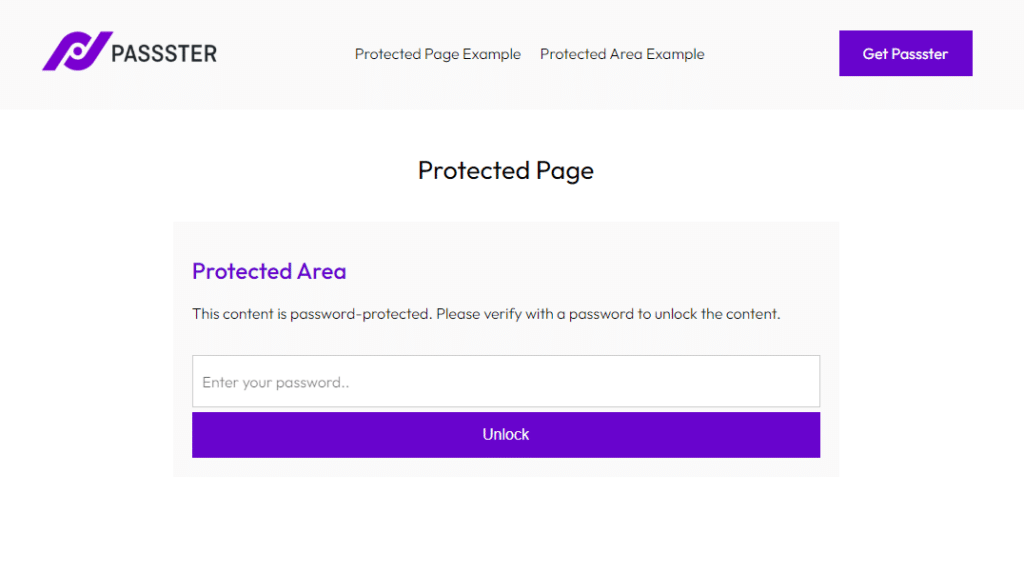
Apart from improving security, password protecting your WordPress site can also enable your users to trust you with their information.
📈 Data privacy is a major concern today, and 70% of consumers are more concerned about security issues than five years ago.
So if you password-protect the pages containing their information, they will be more willing to work with you.
Is the default WordPress password protection sufficient?
By default, WordPress allows you to set the visibility options of your posts or pages as either private or password protected. However, this only works for your WordPress pages and posts. So it won’t be useful if you want to password-protect your entire WordPress site, part of it, or just certain sections of a page.
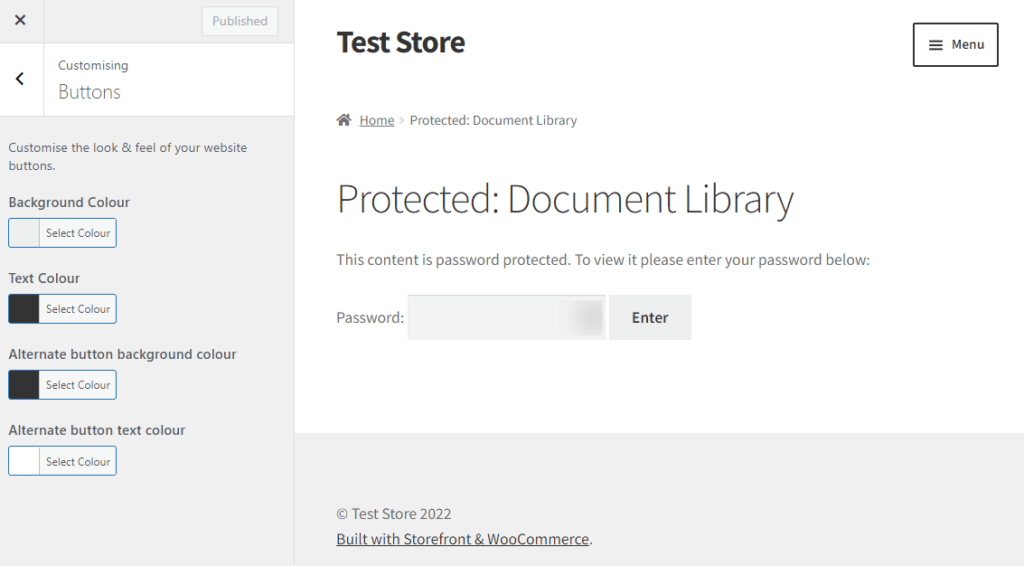
That’s not all. The default WordPress password protection offers very limited security. The passwords can be easily shared, leading to unauthorized access to protected content. Since the passwords don’t expire, unauthorized users will continue to access gated content until you change the password.
To control access to your site properly, improve its security, and diversify how you protect your content, you’ll need the help of a plugin.
What is the best WordPress plugin for a password-protected site?
The Passster plugin is the most secure password WordPress plugin that diversifies how you protect your WordPress website.
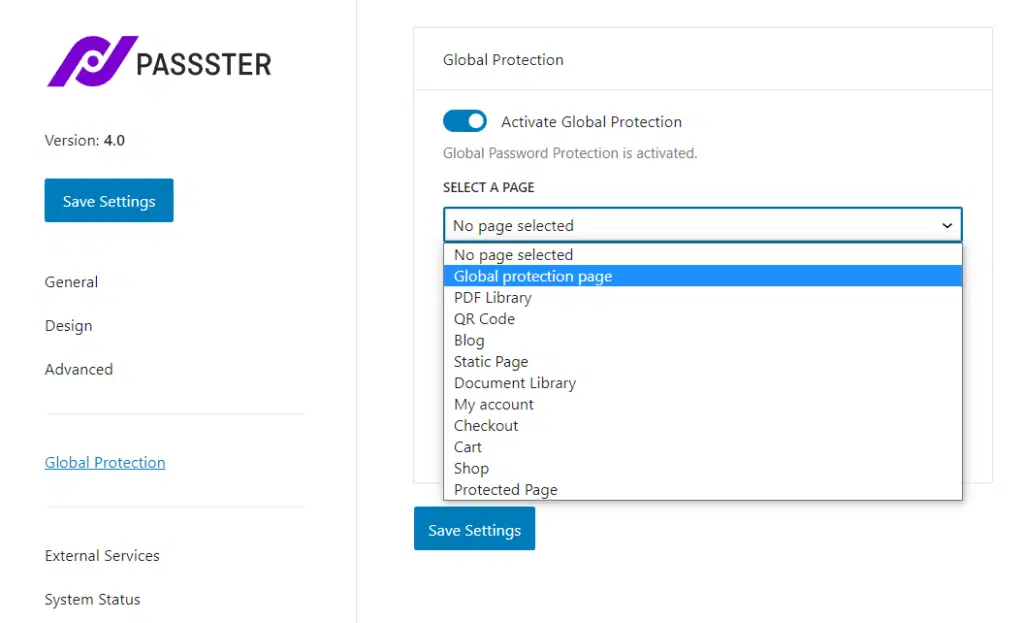
This plugin can password-protect your entire WordPress site or just parts of it. Passster gives you greater control over who can access your content and what content they access.
Passster
Protect your entire website, entire pages, or just parts of your content with one or more passwords.
Using Passster to password protect your WordPress site will give you access to the following features.
Password protection in just a few clicks
Passster makes it extremely easy for you to password protect your WordPress site. You can protect your entire WordPress site (sitewide protection) or single posts/pages (page protection) in just a few clicks. This saves you a lot of time and effort that you would spend creating and maintaining multiple access controls.
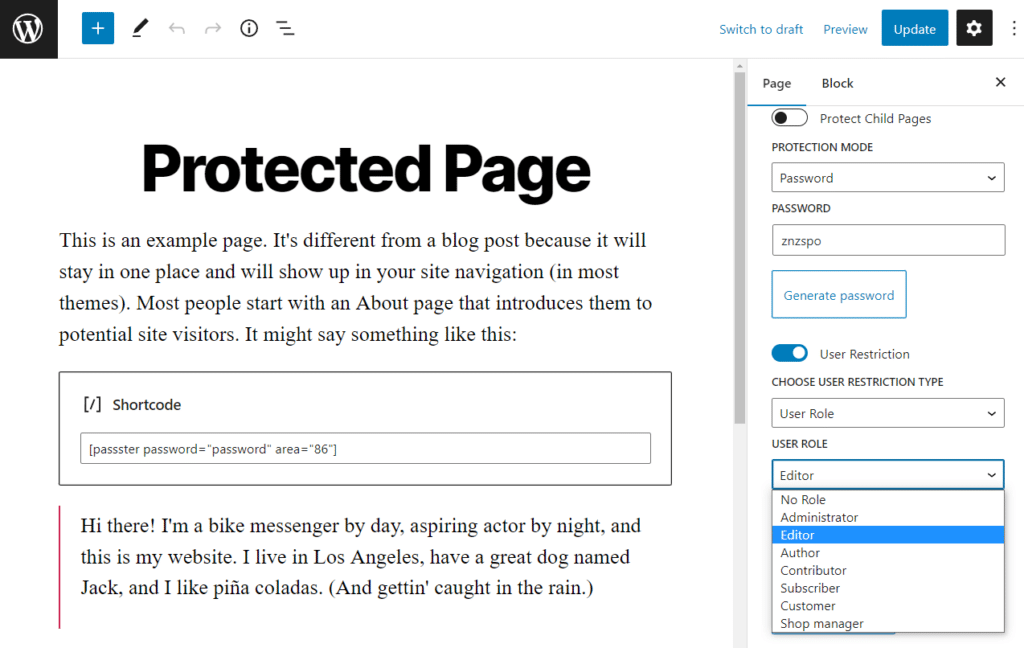
Password protect page sections and WooCommerce products
Passster doesn’t just allow you to protect your entire site and individual pages. You can do the same for specific page sections. Only certain page sections will be inaccessible to unauthorized users, leaving the rest of the page accessible. This feature helps you secure things like forms, download links, etc. and requires users to meet criteria before accessing it.
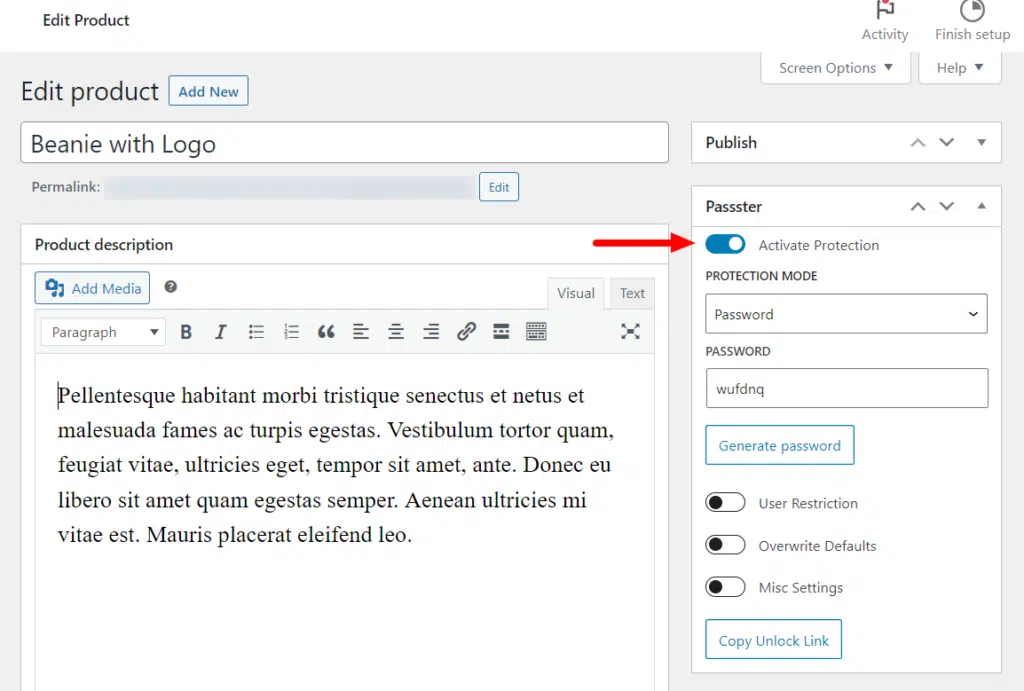
You can also restrict access to WooCommerce products by user role/username. This is useful if you want to separate your retail and wholesale customers or offer exclusive products to members.
Choose the password protection type
With Passster, you can protect your site using the following methods:
- Single passwords, multiple passwords, or a password list.
- Google reCAPTCHA – protect your website from SPAM and bots.
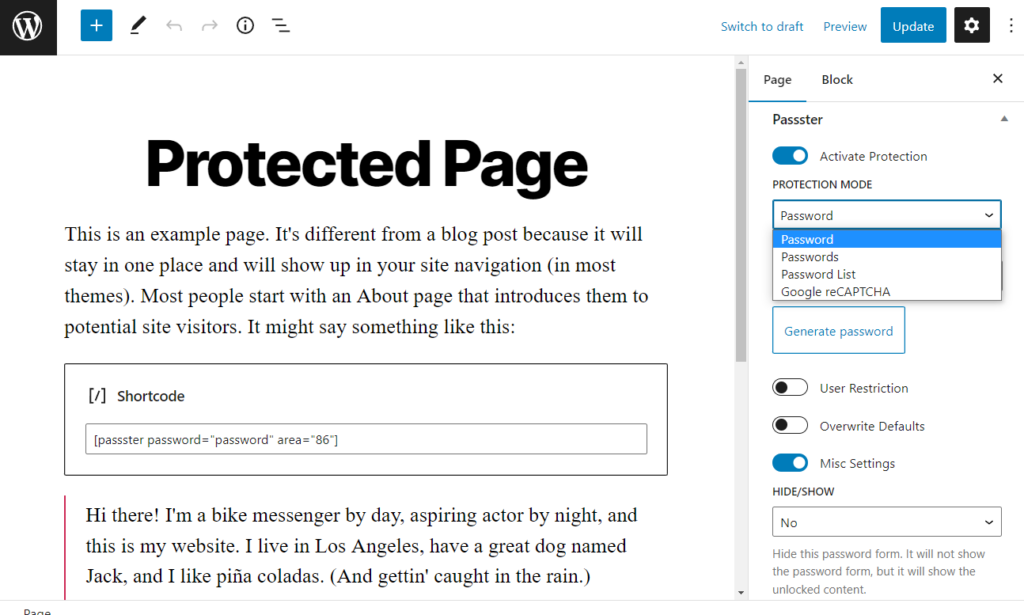
Using different password protection protocols enables you to diversify how you protect your site and improve its security.
To improve your user’s experience, Passster allows you to use cookies so that protected content is automatically unlocked with the same password.
Or use bit.ly to create encrypted links that automatically unlock protected content without the user entering a password.
Track concurrent logins on your website within Passster
Passster lets you track how often a password is used on your website. At the same time, you can prevent unallowed sharing between users and any other form of password misuse.
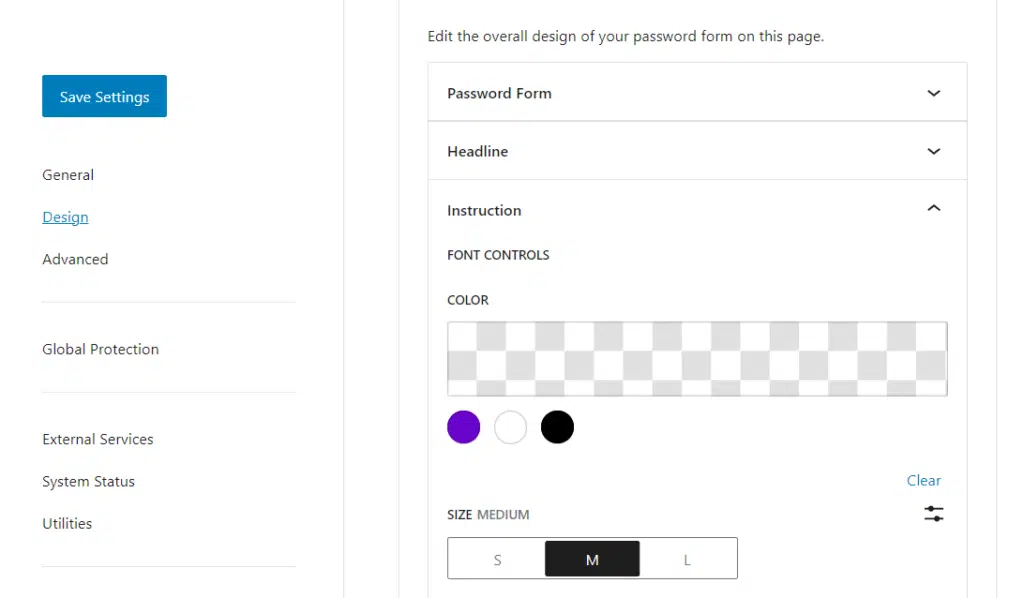
Customize the appearance of the password protection form
Passster allows you to change the design of a password protection form and match it with your WordPress theme. You can easily edit the form’s colors, labels, spacing, hover style, and all relevant content/text to match your global website’s design. Your form’s design will be consistent with the rest of your site’s appearance.
With Passster, you won’t have any issues with compatibility because it works well with all page builders, WordPress themes, and custom post types/fields.
Let’s walk through how to create a password-protected WordPress site with Passster.
How to password protect your entire WordPress site
In this section, we’ll walk you through a step-by-step tutorial on how to password protect your WordPress site.
Step 1: Install Passster on your WordPress site
To get started, you’ll need to purchase the Pro version of Passster here: patrickposner.dev/passster
Passster
Protect your entire website, entire pages, or just parts of your content with one or more passwords.
Download the .zip file sent to your email address. Then, take the following two steps to install Passster on your WordPress website:
- Go to Plugins > Add New on your WordPress dashboard and click the upload button to upload the .zip you’ve downloaded.
- Click on Install Now and then Activate.
Once Passster is activated, you can move to customize your password protection form.
Step 2: Customize your password form
In this section, we’ll edit the content displayed on your password protection forms.
- From your WordPress admin area, go to Passster > Settings and click the General link on your left. In the Form Labels & Description, you will be able to edit the following as it suits you:
- Headline – this is the title or headline of your password protection form.
- Instruction field – You can display a message instructing your users to enter a password to unlock the content.
- Placeholder – You can edit the placeholder text in the password field. For example, “Enter a password” to proceed.
- Error – You can display an error message if the user enters the wrong password.
- Button label – edit the text that will appear on the button. For example, ”Submit.”
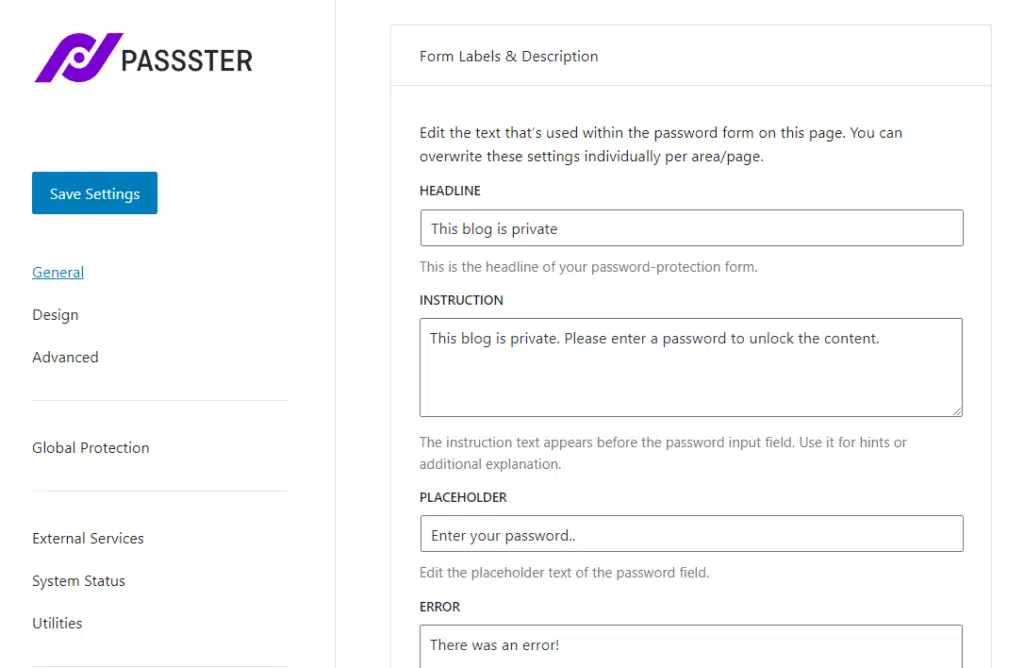
- Click the Save Changes button on the left corner of your screen when you’re finished.
Step 3: Customize the appearance password protection form
Passster allows you to also customize the appearance of your password protection form. Simply follow these steps:
- While still on the plugin settings page, click the Design link to your left and start customization.
- Here, you’ll be able to make the following adjustments:
- Customize the width, colors, spacing, etc., of the form.
- Change the font color, size, and weight of the headline and the instruction.
- Customize the hover states, color, margin, etc., of the button.

- Click the Save settings button at the bottom of the page when you’re happy with all the changes made.
Once all the general settings have been made, it’s time to protect your WordPress site with passwords.
Step 4: Set a password for the whole WordPress website
- Navigate to Passster > Settings > Global Protection from your WordPress dashboard.
- Toggle on the Activate Global Protection switch to enable global password protection.
- Next, select the page you want as your global protection page. You can also exclude pages you don’t want to be protected by a password.
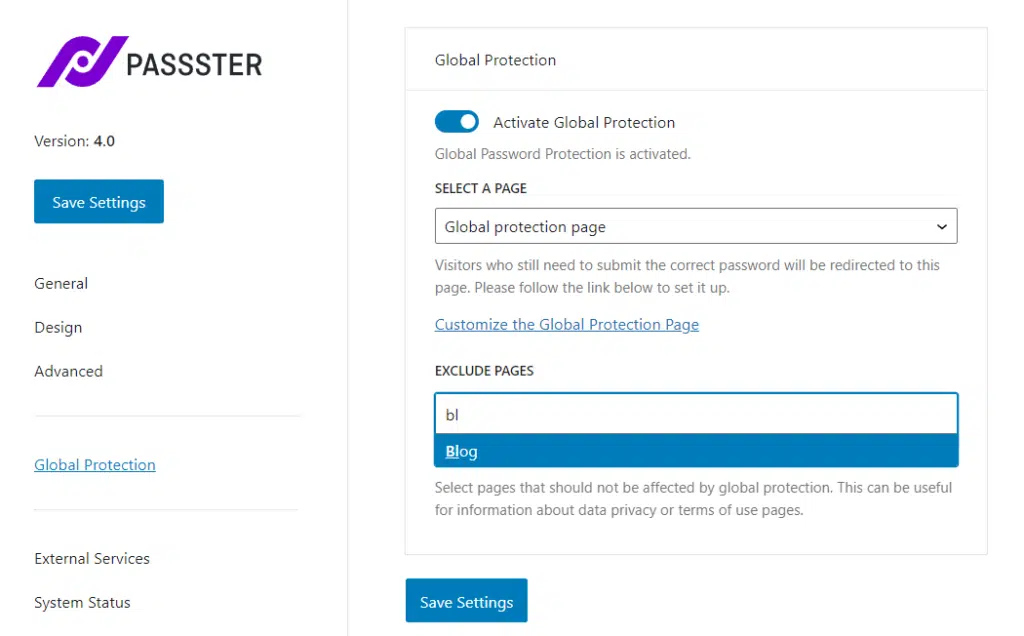
- Click the Save settings button at the bottom to save your changes and move on to the next step.
- Click on the Customize the Global Protection Page link to be taken to your global protection page.
- You can set a password on the right sidebar of the global protection page.
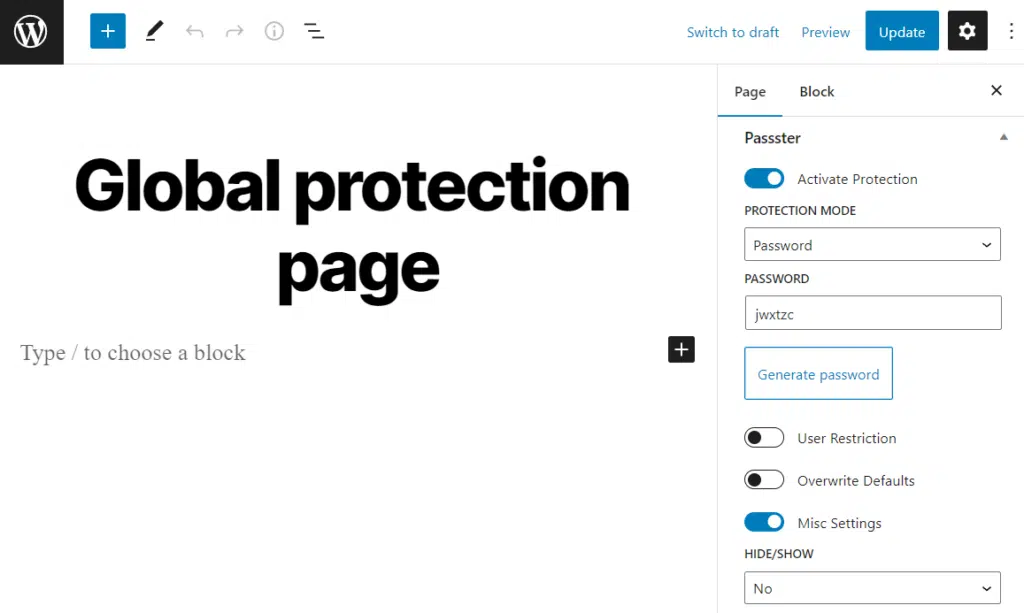
- Finally, click Publish to save your changes.
Password protect individual posts or pages
You can take the following steps if you want to protect individual pages or posts with passwords:
- On your WordPress dashboard, go to Pages > All Pages/Posts and select a page/post of your choice.
- On the right side of the sidebar, you will see a section called Passster.
- Toggle the Activate Protection switch. A password section will drop down, allowing you to select the protection type of your choice.
- You can choose one of these options:
- Password – set a specific password required to access the page.
- Passwords – set multiple passwords to access the same page.
- Password List – select a pre-created password list.
- reCAPTCHA – show visitors a CAPTCHA test they need to pass before accessing the page.

- You can also click the Generate password to get a password.
- In the Redirection field, set the URL to which users will be redirected after successful authentication.
- Click the User Restriction switch if you want to restrict access to this page by user role and define the user roles or usernames to access it.
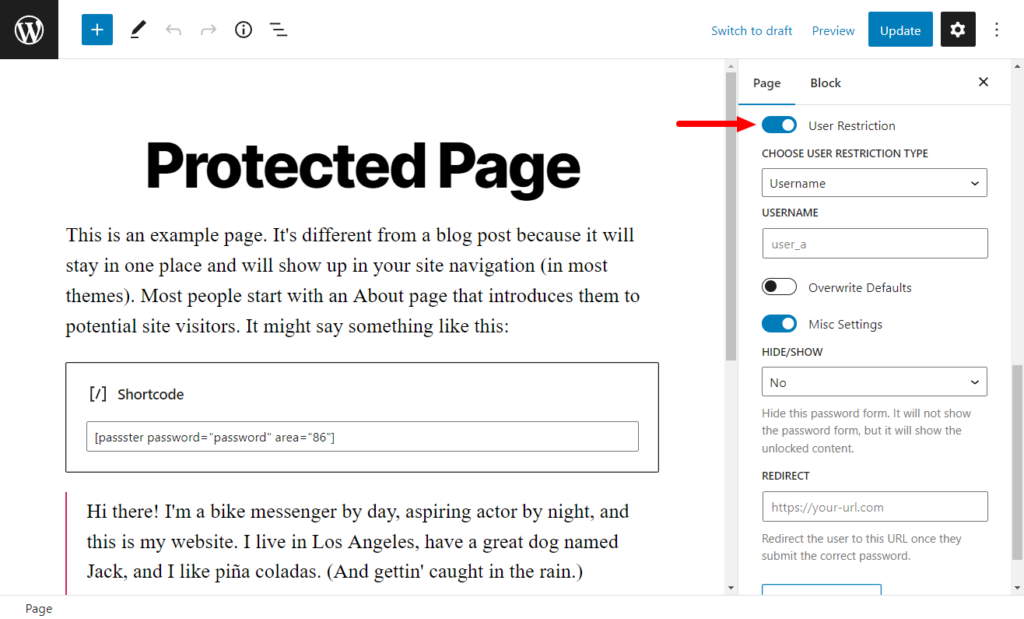
- Click on the Publish button once you’re done.
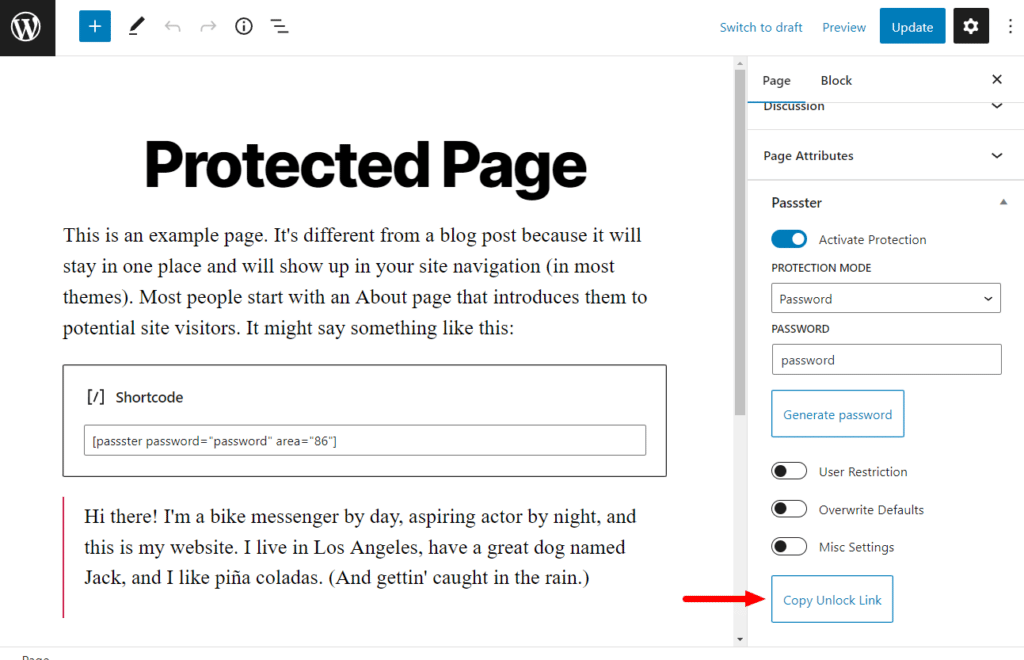
Now your individual posts or pages will require users to enter the password you’ve set before they can access its content.
Password protect your entire WordPress site today
Password-protecting your WordPress site enables you to limit access only to authorized users. This helps you to secure it and prevent your site’s content from falling into the wrong hands. By default, WordPress has a very limited password protection feature.
This is where Passster comes in. Providing secure and fully customizable protection solutions for your entire site, individual pages, and page sections.
With Passster, you’ll have the flexibility to create and manage different access levels, giving you complete control over who can view and interact with your site’s content.
Passster
Protect your entire website, entire pages, or just parts of your content with one or more passwords.